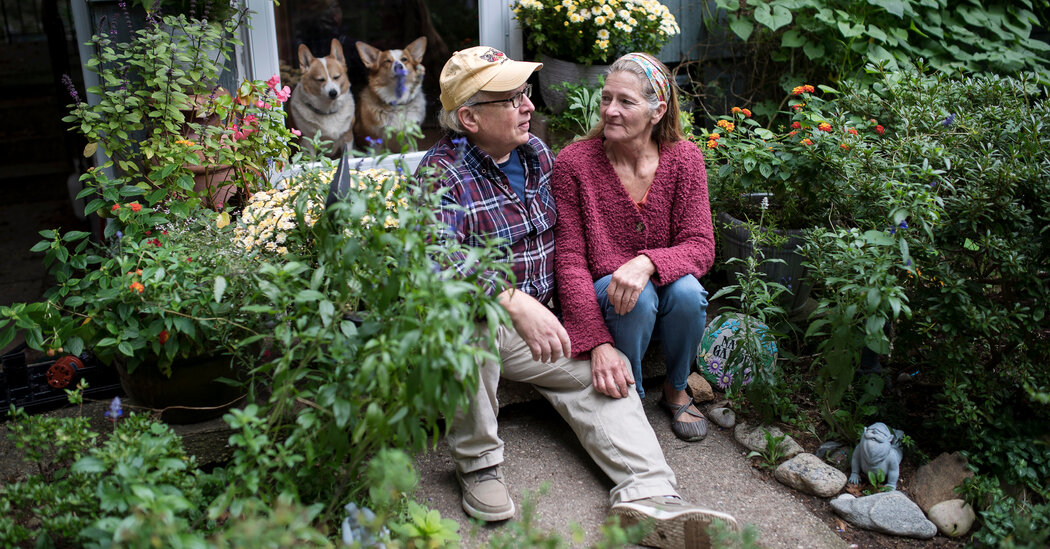
WADING RIVER, N.Y. — If Bill Jacobs were a petty man, or a less religious one, he might look through the thicket of flowers, bushes and brambles that encircle his home and see enemies all around. For to the North, and to the South, and to the West and East and all points in between, stretch acres and acres of lawns.
Lawns that are mowed and edges trimmed with military precision. Lawns where leaves are banished with roaring machines and that are oftentimes doused with pesticides. Lawns that are fastidiously manicured by landscapers like Justin Camp, Mr. Jacobs’s neighbor next door, who maintains his own pristine blanket of green.
“It takes a special kind of person to do something like that,” Mr. Camp said, nodding to wooded wilds of his neighbor’s yard. “I mow lawns for a living, so it’s not my thing.”
Mr. Jacobs and his wife, Lynn Jacobs, don’t have a lawn to speak of, not counting the patch of grass out back over which Mr. Jacobs runs his old manual mower every now and then.
Their house is barely visible, obscured by a riot of flora that burst with colors — periwinkles, buttery yellows, whites, deep oranges, scarlets — from early spring through late fall. They grow assorted milkweeds, asters, elderberry, mountain mint, joe-pye weed, goldenrods, white snakeroot and ironweed. Most are native to the region, and virtually all serve the higher purpose of providing habitats and food to migrating birds and butterflies, moths, beetles, flies and bees.
Mr. Jacobs is an ecologist and a Catholic who believes that humans can fight climate change and help repair the world right where they live. While a number of urban dwellers and suburbanites also sow native plants to that end, Mr. Jacobs says people need something more: To reconnect with nature and experience the sort of spiritual transcendence he feels in a forest, or on a mountain, or amid the bounty of his own yard. It’s a feeling that, for him, is akin to feeling close to God.
“We need something greater than people,” said Mr. Jacobs, who worked at the Nature Conservancy for nine years before joining a nonprofit that tackles invasive species — plants, animals and pathogens that squeeze out native varieties. “We need a calling outside of ourselves, to some sort of higher power, to something higher than ourselves to preserve life on earth.”
Which is why, for years now, Mr. Jacobs has looked beyond the lawns of Wading River, a woodsy hamlet on Long Island’s North Shore, to spread that ethos around the world.
About 20 years ago, he began compiling quotes from the Bible, saints and popes that expound on the sanctity of Earth and its creatures, and posting them online. He considered naming the project after St. Francis of Assisi, the go-to saint for animals and the environment. But, not wanting to impose another European saint on American land, he instead named it after Kateri Tekakwitha, a 17th Century Algonquin-Mohawk woman who converted to Catholicism as a teenager and, in 2012, became the first Native American to be canonized.
“Kateri would’ve known every plant, would’ve collected food, and would’ve been very connected with the land,” Mr. Jacobs said.
Three years ago, Mr. Jacobs took a step further, teaming up with a fellow Catholic ecologist, Kathleen Hoenke, to launch the St. Kateri Habitats initiative, which encourages the creation of wildlife-friendly gardens that feature native plants and offer a place to reflect and meditate (they also teamed up to write a book, “Our Homes on Earth: A Catholic Faith and Ecology Field Guide for Children,” due out in 2023). They enlisted other ecology-minded Catholics, and have since added an Indigenous peoples program and two Indigenous women to their board.
The site is apolitical, runs on donations, and proposes ways people can help mitigate the climate crisis and biodiversity collapse.
“People have to love the Earth before they save it,” Mr. Jacobs said. “So love is the key. We don’t do doomsday stuff.”
There are now about 190 St. Kateri Habitats on five continents, including an eco-village on the isle of Mauritius, a tree nursery in Cameroon, an atrium in Kailua Kona, Hawaii and a suburban backyard in Washington, D.C.
The Jacobses’ yard was the first, and includes non-native plants that birds and insects love like fuchsia, a magnet for hummingbirds, and Ms. Jacobs’s steadily expanding patch of Mexican sunflowers, where, amid the petals, bumblebees often doze off in the late afternoon. Out back, autumn leaves are left in place for overwintering insects, and a years-old pile of fallen branches has become home to generations of chipmunks.
Yet as the number of St. Kateri habitats grew worldwide, and their one-third acre grew more hospitable to wildlife, many of the Jacobses’ neighbors seemed to take the exact opposite tack.
In nearby yards, old trees were felled by the dozens, thinning the neighborhood’s overhead canopy. Noisy machinery replaced rakes, fallen leaves became anathema, and outsourced landscaping, once the purview of the rich, became common. As concerns about tick-borne diseases grew, the popularity of pesticides soared. The Jacobses began carefully moving monarch butterfly eggs and caterpillars to special nests inside their home, to protect them from parasites and drifting chemicals.
For the Jacobses, so-called all-natural or organic pesticides are suspect, too; if a substance is designed to kill one type of insect, they figure it’s bound to hurt others. Hadn’t people heard about the insect apocalypse?
“If you’re a type of being that really has a hard time seeing things die, it’s very troubling,” Ms. Jacobs said during a chat in her garden one recent fall day, raising her voice over the din of a gasoline-powered blower that was shooing leaves from a neighbor’s lawn.
Mr. Jacobs, for his part, looks around at all the pristine lawns (“the lawn is an obsession, like a cult,” he says) and sees ecological deserts that feed neither wildlife nor the human soul. “This is a poverty that most of us are not even aware of,” he said.
Among the lawn-owning Wading River set, sentiments about the Jacobses’ thriving habitat ranges from admiring to indifferent to mixed. A few neighbors have whispered complaints that sometimes rats join the critter parade to the Jacobses’ yard. Mr. Jacobs said they’re drawn to birdseed — and to other neighbors’ yards too — and also that he just invested in new rodent-proof compost bins.
Mr. Camp, the landscaper, maintains a friendly politesse with the Jacobses, and said that as bountiful as their garden was, lawns like his involve far less work. The other landscaper whose property abuts their yard did not respond to requests for comment.
Linda Covello, who lives down the road, and who has also kept a dead tree in place because woodpeckers regularly nest there, described Ms. Jacobs as “some sort of Galadriel from Lord of the Rings.”
“You’ve got your landscaping people out here,” Ms. Covello said, “But she’s the lady of the woods, the goddess of the woods.”
Overall, though, the Jacobses had to concede that locally, their approach to nature wasn’t exactly catching on.
Then a magazine marketing executive named William McCaffrey bought the house across from them in 2020, and moved in with Maxwell, his miniature pinscher.
From the start, Mr. McCaffrey was entranced by the Jacobses’ garden, and took photos as he and Maxwell walked by. He and Ms. Jacobs got to chatting, and he told her that he wanted to gussy up his place, too, and grow wisteria. Ms. Jacobs gently relayed that as beautiful as wisteria was, it was invasive, smothering native plants and starving them of light.
“She told me she could show me alternatives,” Mr. McCaffrey said. “I never really thought about it. She educated me.”
She gave him seeds from her flowers and he planted them along with other native species. This past summer, hummingbirds, monarch butterflies and pairs of goldfinches zipped between the Jacobses’ garden and his. Now Mr. McCaffrey is planning to vastly expand his flower beds, which, per Ms. Jacobs’s counsel, he enriches using leaves from his lawn, to include 30 other kinds of native plants. He has two cars, and thinks about what else he could do in his yard to offset their carbon dioxide emissions.
“I’m a convert,” Mr. McCaffrey said, “It really made me think about how and what I pick for my garden works into the whole cycle.”
He is also noticing the land around him in new ways. One of his favorite trees on his property is a twisty, soaring locust. Gazing at it one day, Mr. McCaffrey realized he could see the shape of a woman in its graceful branches, and now he spots her every time he looks.
“Can you see her?” he said, pointing up to the tree one recent day. “A ballerina.”







